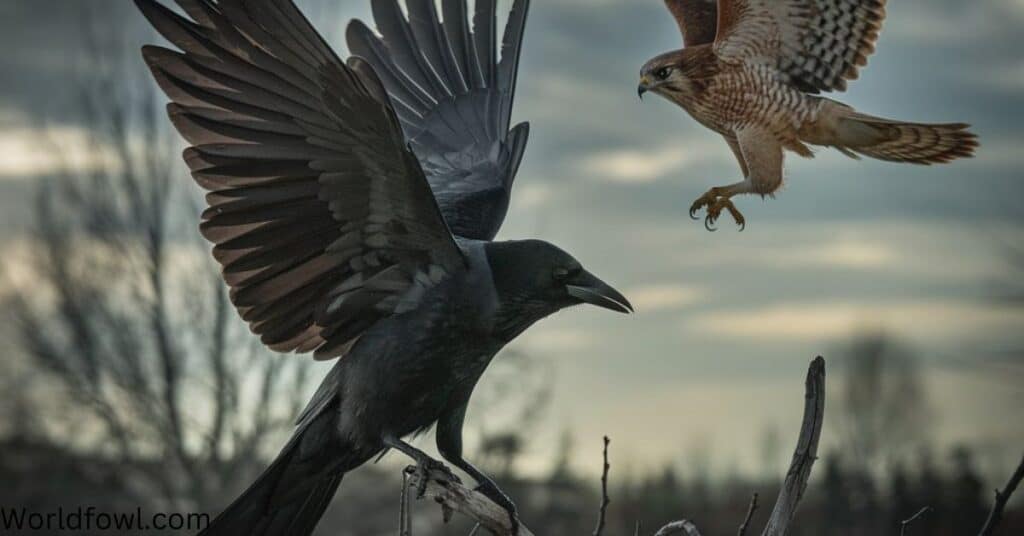In the vast theater of the sky, a curious spectacle often unfolds – Crows Chase Hawks. This aerial drama captivates birdwatchers and casual observers alike, raising questions about the intricate relationships between these avian actors.
The Crows Chase Hawks Dynamic: More Than Meets the Eye
Before we dive into the chase, let’s set the stage by understanding our main characters.
Crows: The Clever Corvids
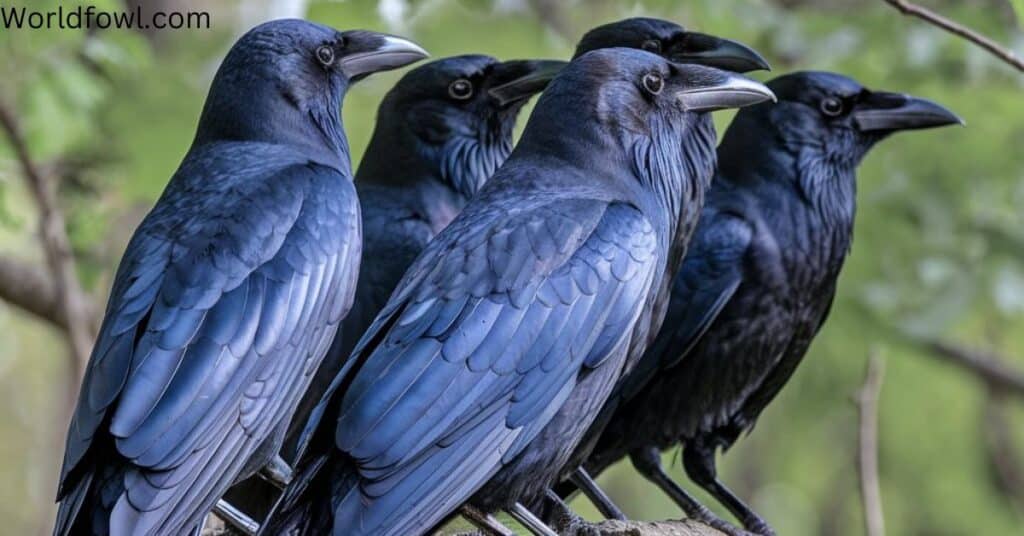
Crows belong to the Corvidae family, known for their intelligence and adaptability. Some notable crow species include:
- American Crow (Corvus brachyrhynchos)
- Common Raven (Corvus corax)
- Hooded Crow (Corvus cornix)
- Large-billed Crow (Corvus macrorhynchos)
Crows are known for their problem-solving abilities, tool use, social behavior, excellent memory, and adaptability to various environments.
Intelligence of Crows
The intelligence of crows is well-documented and continues to astound researchers:
- Tool Use: New Caledonian crows have been observed crafting and using tools to obtain food, a behavior once thought unique to primates.
- Problem-Solving: In laboratory settings, crows have demonstrated the ability to solve complex puzzles, often outperforming young children in certain tasks.
- Facial Recognition: Crows can recognize and remember human faces, holding grudges against those who have wronged them and even passing this information to their offspring.
- Social Learning: Crows learn from each other, passing knowledge through generations, a form of cultural transmission rarely seen in non-human animals.
- Adaptability: Crows thrive in diverse environments, from urban centers to rural areas, showcasing their ability to adapt to changing conditions.
Hawks: The Skilled Hunters
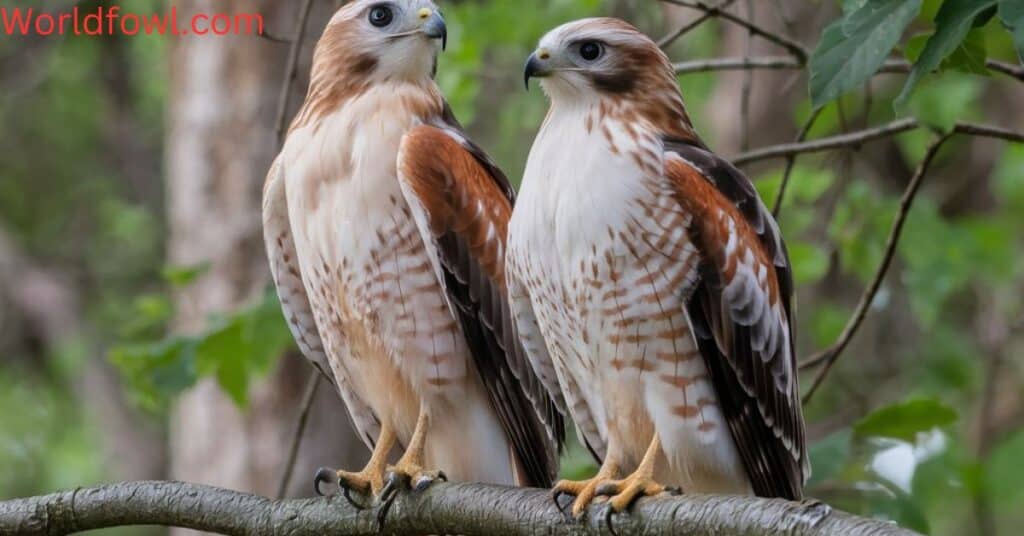
Hawks are birds of prey belonging to the family Accipitridae. Some common hawk species include:
- Red-tailed Hawk (Buteo jamaicensis)
- Cooper’s Hawk (Accipiter cooperii)
- Sharp-shinned Hawk (Accipiter striatus)
- Northern Goshawk (Accipiter gentilis)
Hawks are characterized by sharp, hooked beaks, powerful talons, excellent eyesight, swift flying abilities, and predatory nature.
Hunting Prowess of Hawks
Hawks are apex predators, equipped with a range of adaptations that make them formidable hunters:
- Keen Eyesight: Hawks have vision that is 8 times sharper than that of humans, allowing them to spot prey from great distances.
- Silent Flight: Many hawk species have evolved special feather structures that allow for near-silent flight, enabling them to approach prey undetected.
- Powerful Talons: Hawks possess strong, curved talons designed for grasping and killing prey efficiently.
- Agile Flight: Hawks can perform impressive aerial maneuvers, including quick turns and steep dives, to catch prey in mid-air or on the ground.
- Varied Hunting Techniques: Different hawk species employ diverse hunting strategies, from sit-and-wait tactics to high-speed pursuits.
Why Do Crows Chase Hawks?
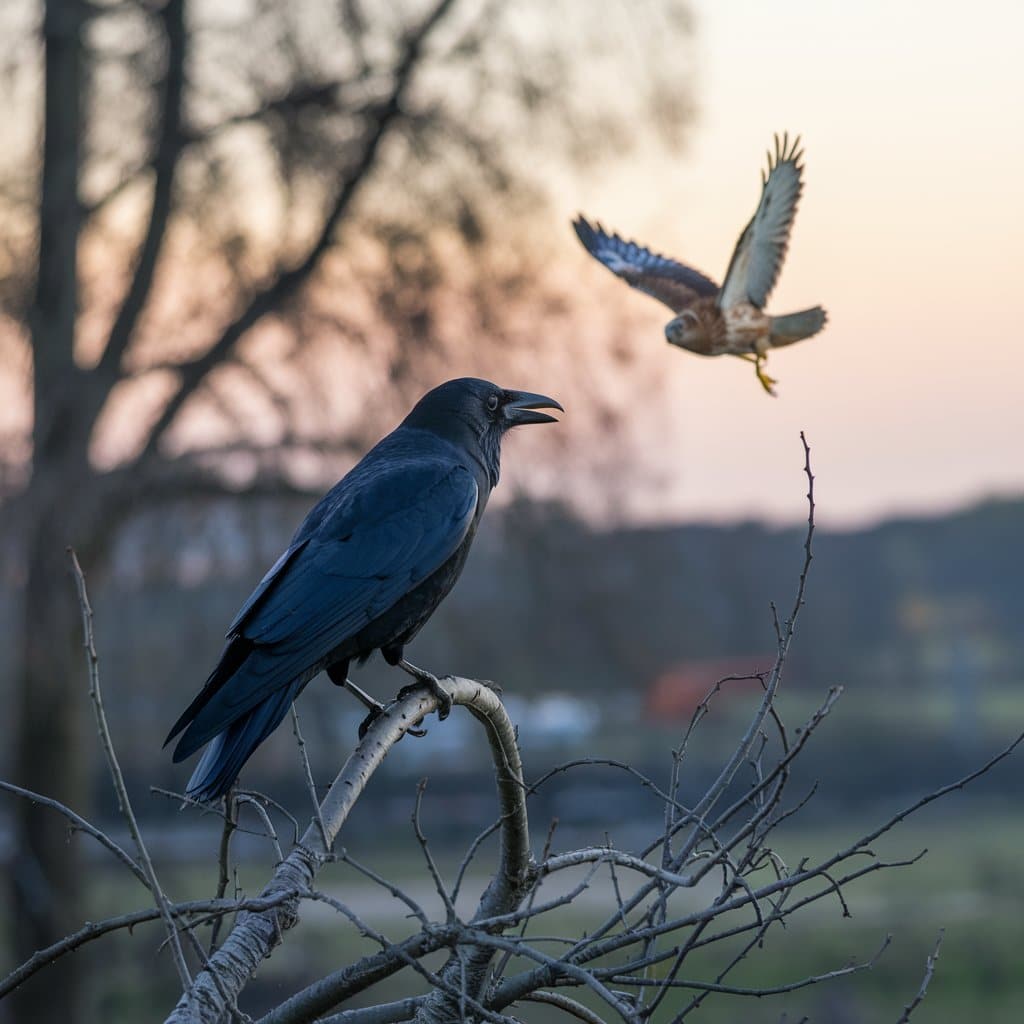
The sight of crows pursuing hawks is not uncommon, but the reasons behind this behavior are multifaceted:
1. Territorial Defense
Crows are fiercely protective of their territories, especially during nesting season. They view hawks as potential threats to their nests and offspring.
Case Study: A 2018 study in the Journal of Avian Biology observed that American Crows increased their mobbing behavior against Red-tailed Hawks by 50% during nesting season compared to other times of the year.
Nesting Behavior of Crows
Understanding crow nesting behavior provides insight into their territorial nature:
- Crows typically nest in trees, building large, sturdy nests of sticks lined with softer materials.
- The nesting season varies by region but generally occurs between March and July.
- Both male and female crows participate in nest building and defend the territory.
- Crows often have “helpers” at the nest, usually offspring from previous years, who assist in defending the territory and caring for new chicks.
2. Predator Deterrence
Hawks are known predators of smaller birds, including crows. By chasing hawks, crows aim to discourage hawks from hunting in their area, protect themselves and their flock members, and send a clear message: “This is not your hunting ground!”
Effectiveness of Mobbing as Deterrence
Research has shown that mobbing can be an effective deterrent:
- A study published in the journal Animal Behaviour found that predators were less likely to return to areas where they had been mobbed.
- Mobbing not only protects the immediate area but can also create a “landscape of fear” for predators, making them less likely to hunt in regions with high mobbing activity.
3. Opportunistic Behavior
Crows are opportunists, and their pursuit of hawks isn’t always about defense. Sometimes, it’s about kleptoparasitism (stealing food from hawks) or curiosity (investigating potential food sources or threats).
Kleptoparasitism in Crows
Kleptoparasitism, or food theft, is a common behavior among crows:
- Crows have been observed following hawks and other predators, waiting for them to make a kill.
- Once the predator has caught prey, crows may harass it, trying to force it to drop the food.
- This behavior is not limited to interactions with hawks; crows also steal food from other birds, mammals, and even humans.
4. Mobbing as a Learning Experience
Young crows often participate in chasing hawks as a form of learning. This behavior helps them identify potential predators, practice defensive techniques, and strengthen social bonds within the flock.
Social Learning in Crow Flocks
The importance of social learning in crow societies cannot be overstated:
- Young crows learn critical life skills by observing and participating in flock activities.
- Mobbing provides a relatively safe way for young crows to interact with predators and learn their behaviors.
- These experiences help shape the young crows’ future responses to threats and contribute to the overall survival strategy of the flock.
The Art of Mobbing: Crows’ Strategic Warfare
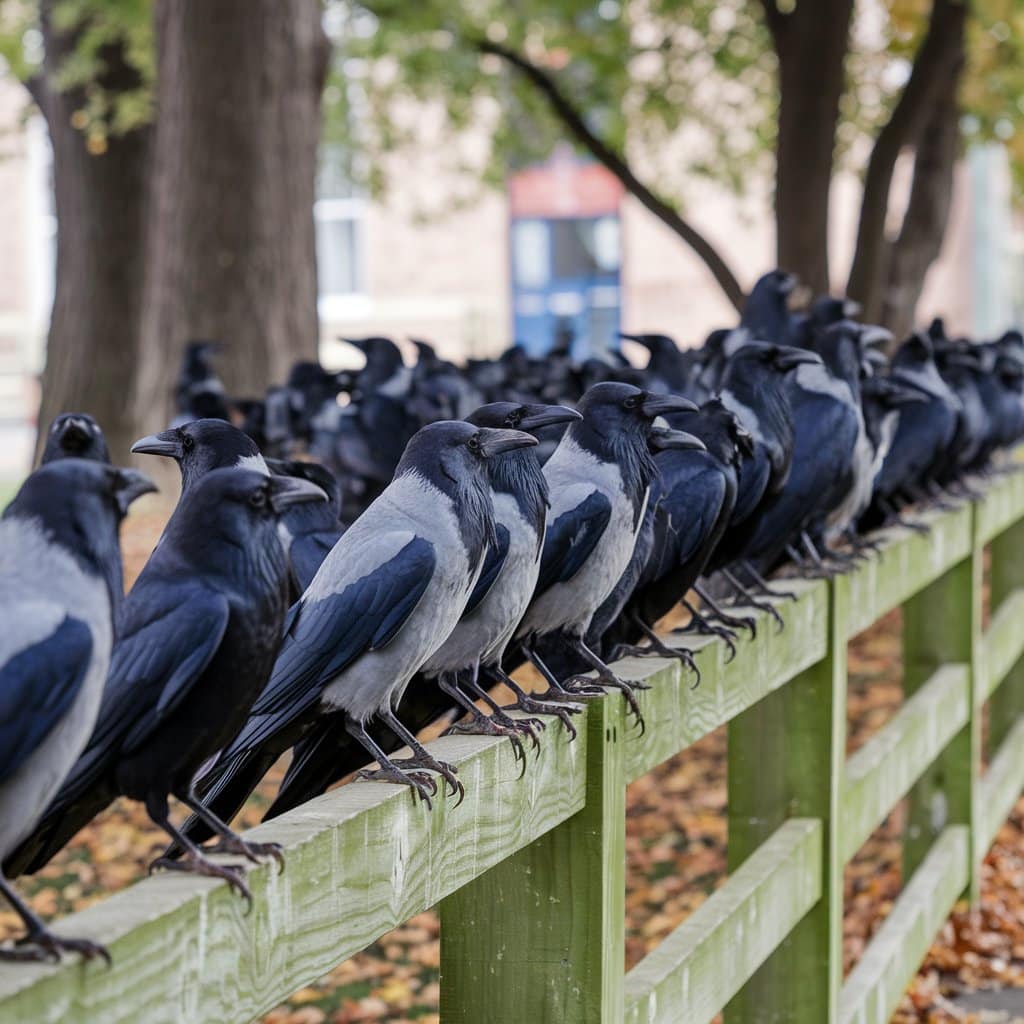
Mobbing is a collective behavior where smaller birds harass a larger predator. It’s not unique to crows but is particularly notable in their interactions with hawks.
How Mobbing Works
- Alert Call: A crow spots a hawk and makes a distinctive call.
- Gathering: Other crows in the vicinity respond and gather.
- Coordinated Attack: The group dives at the hawk, often taking turns.
- Persistence: The mobbing continues until the hawk leaves the area.
Mobbing serves several purposes: it confuses and disorients the predator, signals to other birds about the presence of a threat, and may result in the predator leaving the area.
The Science Behind Mobbing Calls
Crow vocalizations during mobbing are more than just noise:
- Researchers have identified specific acoustic features in mobbing calls that convey information about the type and level of threat.
- These calls can communicate the size, location, and movement of the predator to other crows in the area.
- Some studies suggest that crows can even differentiate between calls for different types of predators, allowing for a more tailored response.
Mobbing Strategies
Crows employ various strategies during mobbing:
- Dive-bombing: Crows swoop down at the hawk from above, often pulling up at the last moment.
- Surrounding: Multiple crows encircle the hawk, attacking from different angles.
- Chasing: Crows pursue the hawk in flight, harassing it as it tries to escape.
- Vocal Assault: Loud, persistent cawing accompanies the physical attacks, adding to the disorientation of the predator.
Crow Species Known for Chasing Hawks
While many crow species engage in mobbing behavior, some are particularly known for their boldness in confronting hawks:
- American Crows (Corvus brachyrhynchos)
- Common Ravens (Corvus corax)
- Hooded Crows (Corvus cornix)
- Northwestern Crows (Corvus caurinus)
Regional variations in behavior exist, influenced by factors such as local predator populations, available food resources, and habitat characteristics.
American Crows: The Bold Mobbers
American Crows are perhaps the most well-known for their mobbing behavior:
- Found across North America, these crows are highly adaptable and thrive in various habitats.
- They form large, social groups which contribute to effective mobbing strategies.
- American Crows are known to mob a wide variety of predators, not just hawks.
Common Ravens: The Largest Corvids
While technically not crows, Common Ravens are closely related and known for their interactions with hawks:
- Larger than crows, ravens are more evenly matched with some hawk species.
- Ravens are often bolder in their confrontations, sometimes engaging in one-on-one battles with hawks.
- Their intelligence and problem-solving abilities make them formidable opponents in aerial confrontations.
Hooded Crows: The European Mobbers
Hooded Crows, found in Europe and parts of Asia, are also known for their aggressive mobbing behavior:
- These crows often form mixed-species flocks, collaborating with other corvids in mobbing activities.
- Their distinct appearance, with gray bodies and black heads, makes their mobbing behavior easily identifiable.
Northwestern Crows: Coastal Specialists
Northwestern Crows, found along the Pacific Northwest coast, have their own unique mobbing behaviors:
- These crows are often seen mobbing Bald Eagles, which are common in their coastal habitat.
- Their mobbing behavior is particularly intense during the breeding season when they fiercely defend their nesting areas. Crows Chase Hawks
The Limits of Aggression: Do Crows Kill or Eat Hawks?
While crows are aggressive in their mobbing behavior, it’s rare for them to actually kill or eat hawks. Instances of crow-on-hawk violence are uncommon, and when they do occur, it’s usually a result of prolonged mobbing by a large group.
Crows are omnivores with a diverse diet, including seeds, fruits, insects, small animals, and carrion. Hawks are not a typical food source for crows. When crows do scavenge on hawk carcasses, it’s opportunistic rather than predatory behavior.
It’s important to clarify some common misconceptions:
- Crows are not inherently violent; their mobbing behavior is defensive, not offensive.
- Hawks are generally larger and more powerful, making them difficult prey for crows. Crows Chase Hawks
- Killing a hawk would require significant energy, which is not beneficial for crows in most situations.
Rare Instances of Crow Aggression
While uncommon, there have been documented cases of extreme crow aggression towards hawks:
- In 2014, wildlife biologists in Washington state observed a group of crows killing a Cooper’s Hawk after prolonged mobbing.
- Occasionally, large groups of crows may fatally injure a hawk, especially if it’s already weakened or injured.
These events are the exception rather than the rule and often occur under unusual circumstances.
Turning the Tables: Hawks as Predators
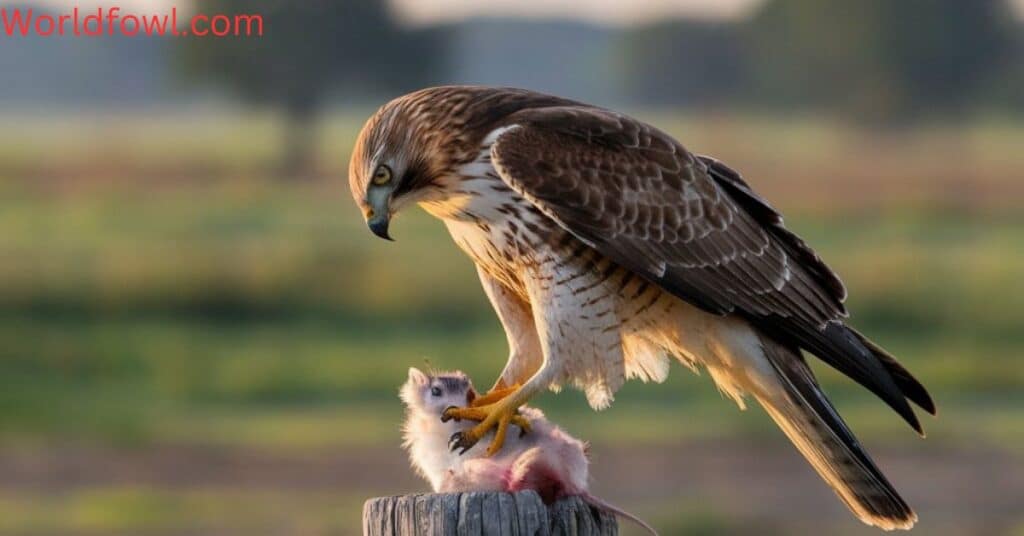
While we often focus on crows chasing hawks, it’s crucial to remember that hawks are formidable predators in their own right. Hawks do sometimes prey on crows, especially younger, inexperienced crows, solitary crows separated from their group, or crows that are sick or injured.
Hawks have several advantages over crows:
- Sharp talons and beaks designed for catching and killing prey
- Excellent vision that can spot potential prey from great distances
- Swift and agile flight allowing for surprise attacks
Strategies hawks use to catch crows include surprise attacks, isolating individuals from the group, and persistent pursuit of a chosen target.
Hawk Species Known to Prey on Crows
Not all hawk species pose an equal threat to crows. Some are more likely to target crows than others:
- Northern Goshawk (Accipiter gentilis): Known for their aggression and ability to maneuver through forests, goshawks are formidable predators of crows.
- Cooper’s Hawk (Accipiter cooperii): These woodland hawks are agile flyers and often prey on medium-sized birds, including crows.
- Red-tailed Hawk (Buteo jamaicensis): While they more commonly prey on small mammals, large red-tailed hawks may occasionally take crows.
Hunting Techniques Used by Hawks
Hawks employ various strategies when hunting crows:
- Surprise Attacks: Hawks may use terrain or vegetation as cover to launch sudden attacks on unsuspecting crows.
- Pursuit Flights: Some hawk species, particularly accipiters like the Cooper’s Hawk, are adept at chasing down prey in flight.
- Isolating Individuals: Hawks may target crows that have become separated from their group, as solitary crows are more vulnerable.
- Exploiting Vulnerability: Hawks often target juvenile, sick, or injured crows that are less able to defend themselves or escape.
The Emotional Angle: Do Crows Actually Hate Hawks?
It’s tempting to anthropomorphize animal behavior, but attributing human emotions to animals can lead to misunderstandings. From a scientific perspective, crows’ reactions to hawks are likely driven by: Crows Chase Hawks
- Instinctive responses: Hardwired behaviors to potential threats
- Learned behaviors: Experiences that reinforce the need for caution around hawks
- Social dynamics: Group behavior that enhances survival chances
The role of instinct versus learned behavior in crow-hawk interactions involves innate fear of predator shapes, sizes, and movements, young crows observing and mimicking adults’ responses to hawks, and crows remembering and recognizing individual hawks that have posed threats in the past.
The Role of Memory in Crow Behavior
Crows’ remarkable memory plays a significant role in their interactions with hawks:
- Studies have shown that crows can remember human faces for years, associating them with positive or negative experiences.
- This same ability likely extends to their interactions with hawks, allowing crows to recognize and respond to individual hawks that have posed threats in the past. Crows Chase Hawks
- Crows may pass this information to their offspring, creating a generational memory of potential threats.
Social Learning and Cultural Transmission
The social nature of crows contributes to their behavior towards hawks:
- Young crows learn from observing the reactions of older, more experienced crows.
- Mobbing behaviors and alarm calls can be culturally transmitted within crow populations.
- This social learning allows crow populations to adapt quickly to new threats or changes in predator behavior.
Hawk’s Perspective: Reaction to Crow Harassment
Hawks often seem to ignore mobbing crows, which might appear puzzling. This behavior is likely due to:
- Energy Conservation: Responding to every mobbing attempt would be exhausting
- Focus on Hunting: Hawks prioritize finding prey over reacting to harassers
- Risk Assessment: Hawks can usually outfly crows if truly threatened
While rare, hawks do sometimes retaliate through sudden turns, counter-attacks, or intimidation displays to deter crows.
Hawk Adaptations to Cope with Mobbing
Hawks have developed various strategies to deal with mobbing behavior: Crows Chase Hawks
- Increased Vigilance: Hawks in areas with high crow populations may be more alert and quicker to take evasive action.
- Altered Hunting Patterns: Some hawks may adjust their hunting times or locations to avoid peak crow activity.
- Rapid Departures: When mobbed, hawks often opt for a swift exit from the area rather than engaging with the crows.
- Use of Terrain: Hawks may use landscape features like forests or hills to break line-of-sight with mobbing crows and escape harassment.
The Bigger Picture: Ecological Balance
The crow-hawk dynamic plays a crucial role in maintaining ecological balance:
- Population Control: Hawks help control crow populations, and vice versa
- Behavioral Adaptation: Both species continually evolve strategies, promoting biodiversity
- Scavenging: Crows clean up carrion, including hawk leftovers, aiding in nutrient cycling
The presence of both crows and hawks impacts other species as well. Other birds benefit from crows’ mobbing behavior as an early alert system, and the competition between crows and hawks encourages other species to find unique ecological niches. activities also affect crow-hawk interactions through habitat changes, feeding practices, and conservation efforts.
Impact on Other Species
The crow-hawk relationship has far-reaching effects on the broader ecosystem:
- Predator-Prey Dynamics: The presence of hawks influences the behavior and population dynamics of not just crows, but also other potential prey species.
- Nesting Behavior: Smaller bird species may adjust their nesting locations based on the presence of both crows and hawks in an area.
- Foraging Patterns: The activity of crows and hawks can influence when and where other species choose to feed.
- Community Composition: The balance between crows and hawks can affect the overall bird community composition in an ecosystem.
Human Influence on Crow-Hawk Interactions
Human activities have significant impacts on the relationship between crows and hawks:
- Habitat Alteration: Urban development, deforestation, and agriculture change the landscape, affecting the territories and hunting grounds of both species.
- Supplemental Feeding: Human food sources, intentional or not, can alter the distribution and behavior of crows, indirectly affecting their interactions with hawks.
- Pesticide Use: The use of rodenticides and insecticides can affect the prey base for both crows and hawks, potentially intensifying competition.
- Climate Change: Shifting weather patterns and temperatures can alter the timing of breeding seasons and migration, potentially creating mismatches in crow-hawk interactions.
Observing Crow-Hawk Interactions
For those interested in witnessing these fascinating behaviors firsthand, here are some tips:
- Timing is Key: Dawn and dusk are often active times for both species
- Look for Hotspots: Areas with open spaces near wooded areas are ideal
- Listen for Alarm Calls: Crows’ distinctive caws often signal the presence of a hawk
- Use Binoculars: Observe from a distance to avoid disturbing the birds
Good locations for observation include urban parks, forest edges, and areas where open spaces meet wooded regions. Spring and early summer during nesting season often see increased activity.
When observing, it’s important to maintain a respectful distance, never interfere with natural behaviors, and avoid disturbing nests or feeding areas.
Best Practices for Birdwatching
To ensure a positive experience for both observers and birds:
- Follow Ethical Guidelines: Adhere to birdwatching codes of conduct, such as those provided by the American Birding Association.
- Use Appropriate Equipment: Invest in good binoculars or a spotting scope to observe from a distance without disturbing the birds. Crows Chase Hawks
- Keep a Field Journal: Record your observations, including date, time, location, and behavior witnessed. This can contribute to citizen science efforts.
- Join Local Birding Groups: Connecting with experienced birdwatchers can enhance your knowledge and observation skills. Crows Chase Hawks
- Respect Wildlife Laws: Be aware of and follow all local, state, and federal regulations regarding wildlife observation and protection. Crows Chase Hawks
Research and Conservation Efforts
The interactions between crows and hawks have attracted significant scientific interest:
Current Research
- Cognitive Studies: Ongoing research into crow intelligence and problem-solving abilities helps us understand their complex behaviors, including mobbing.
- Urban Ecology: Studies on how urban environments affect crow and hawk populations and their interactions provide insights into adaptation in human-modified landscapes.
- Vocal Communication: Research into the nuances of crow vocalizations during mobbing events is revealing the complexity of their communication systems.
Conservation Implications
Understanding crow-hawk dynamics is crucial for conservation efforts:
- Habitat Protection: Preserving diverse habitats that support both species is essential for maintaining natural interactions and ecological balance.
- Monitoring Programs: Long-term monitoring of crow and hawk populations helps track changes in their relationships and overall ecosystem health.
- Public Education: Raising awareness about the ecological roles of both crows and hawks can foster greater appreciation and support for conservation efforts.
Conclusion
The dynamic between crows and hawks is a captivating example of nature’s complexity. Far from a simple tale of conflict, it’s a nuanced interaction shaped by instinct, intelligence, and ecological pressures.
Key takeaways include:
- Crows chase hawks for various reasons, including territorial defense and opportunism
- Mobbing is a strategic behavior that serves multiple purposes
- The relationship between crows and hawks is bidirectional, with each species impacting the other
- These interactions play a crucial role in maintaining ecological balance
The aerial dramas between crows and hawks remind us of the ongoing evolutionary dance in nature, where species continuously adapt to each other’s strategies. It highlights the importance of preserving biodiversity and the habitats that support these complex interactions.
As human activities continue to shape and often challenge natural ecosystems, understanding these intricate relationships becomes ever more crucial. Conservation efforts that take into account the complex dynamics between species like crows and hawks are more likely to succeed in preserving the delicate balance of our natural world.
The next time you witness a crow chasing a hawk, remember the layers of complexity behind this aerial drama – a testament to the endless fascination nature provides. It’s a reminder of the intricate connections that exist in the natural world, often hidden from casual observation but profoundly important to the functioning of ecosystems.
In the end, the crow-hawk dynamic is not just about two species in conflict, but a reflection of the broader principles of ecology, evolution, and the delicate balance that sustains life on our planet. It challenges us to look beyond surface appearances and consider the deeper stories unfolding in the skies above us.
FAQs
Are hawks afraid of crows?
While hawks aren’t typically afraid of crows, they may avoid areas with large crow populations to conserve energy and reduce harassment.
Can crows and hawks ever coexist peacefully?
Yes, in areas with abundant resources and minimal competition, crows and hawks can coexist with limited conflict.
How do other birds react to crow-hawk chases?
Many smaller birds benefit from crows’ mobbing behavior, using it as an early warning system for predator presence.
Do crows chase other birds of prey?
Yes, crows are known to mob various birds of prey, including owls and eagles, not just hawks.
How can I tell if I’m witnessing mobbing behavior?
Look for multiple crows dive-bombing or chasing a larger bird, often accompanied by loud, persistent cawing.
Do crows ever get injured during these confrontations with hawks?
While rare, injuries can occur, especially if a hawk decides to counterattack. However, mobbing behavior is generally designed to minimize risk to the crows.
Are there any benefits for hawks in areas with high crow populations?
Despite the harassment, hawks may benefit from the presence of crows as they can serve as potential prey or lead hawks to food sources.
How do scientists study crow-hawk interactions?
Researchers use various methods, including field observations, GPS tracking, vocal analysis, and controlled experiments to study these interactions.
Can understanding crow-hawk dynamics help in urban wildlife management?
Yes, insights into these interactions can inform urban planning and wildlife management strategies to promote biodiversity in cities.
Are there any cultural or mythological significance to crow-hawk interactions?
Many cultures have folklore and myths involving crows and hawks, often symbolizing conflict between cunning and strength or representing different natural forces.

Henry James is a seasoned blogger and a passionate storyteller on “World Fowl.” With years of experience crafting engaging content, he brings a unique blend of expertise and creativity to his writing. Henry specializes in exploring diverse topics with depth and clarity, captivating readers worldwide.

